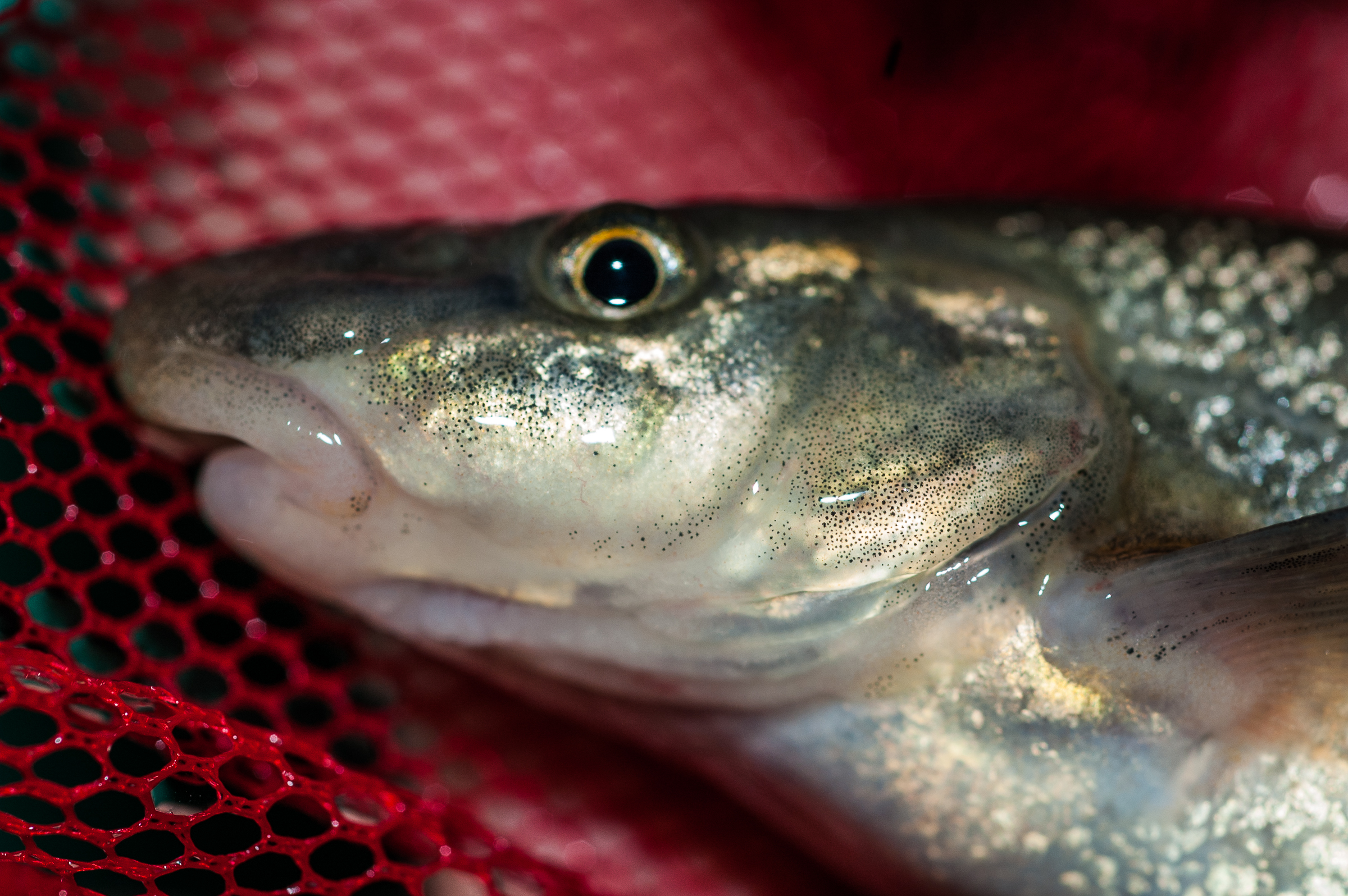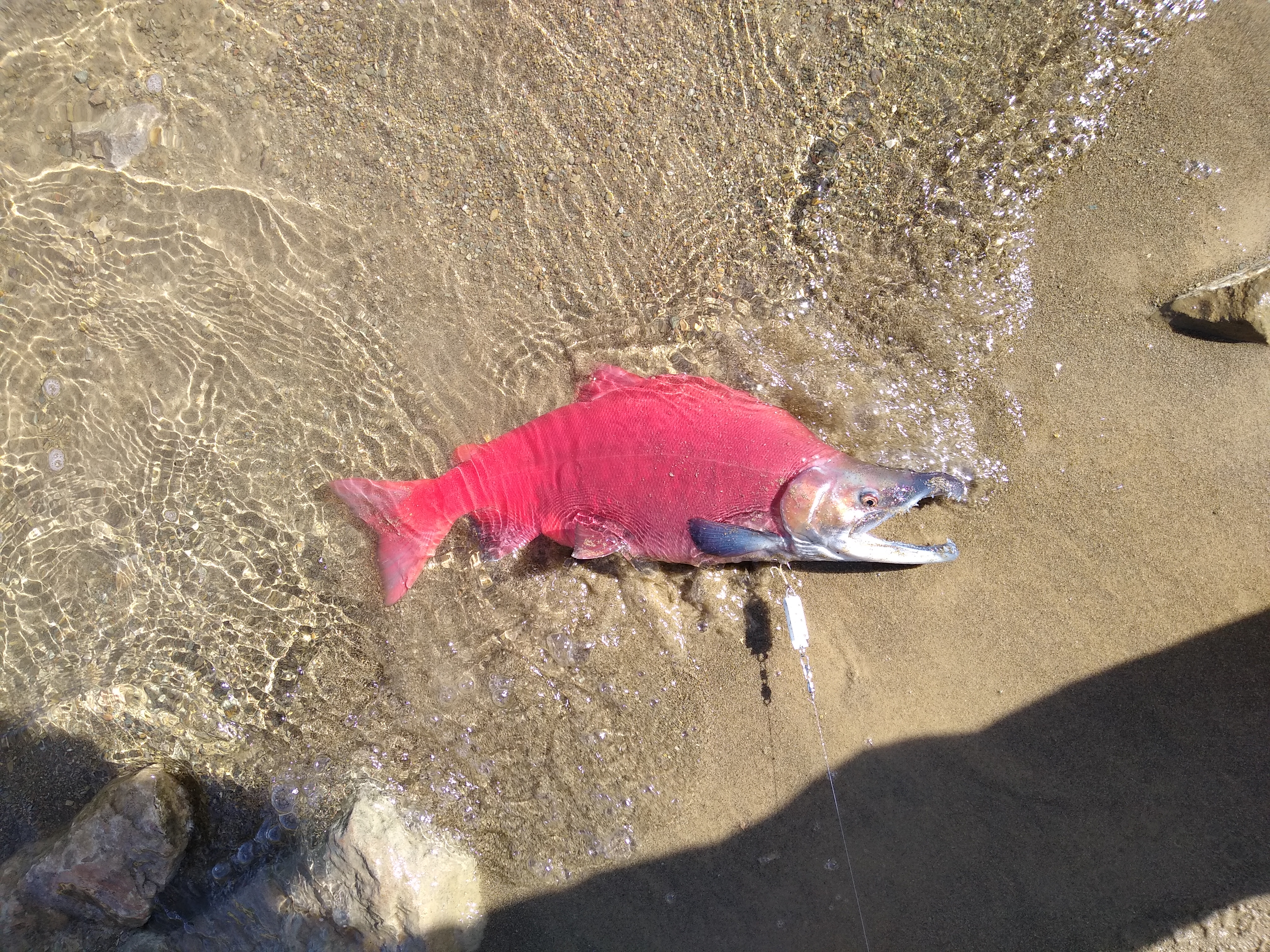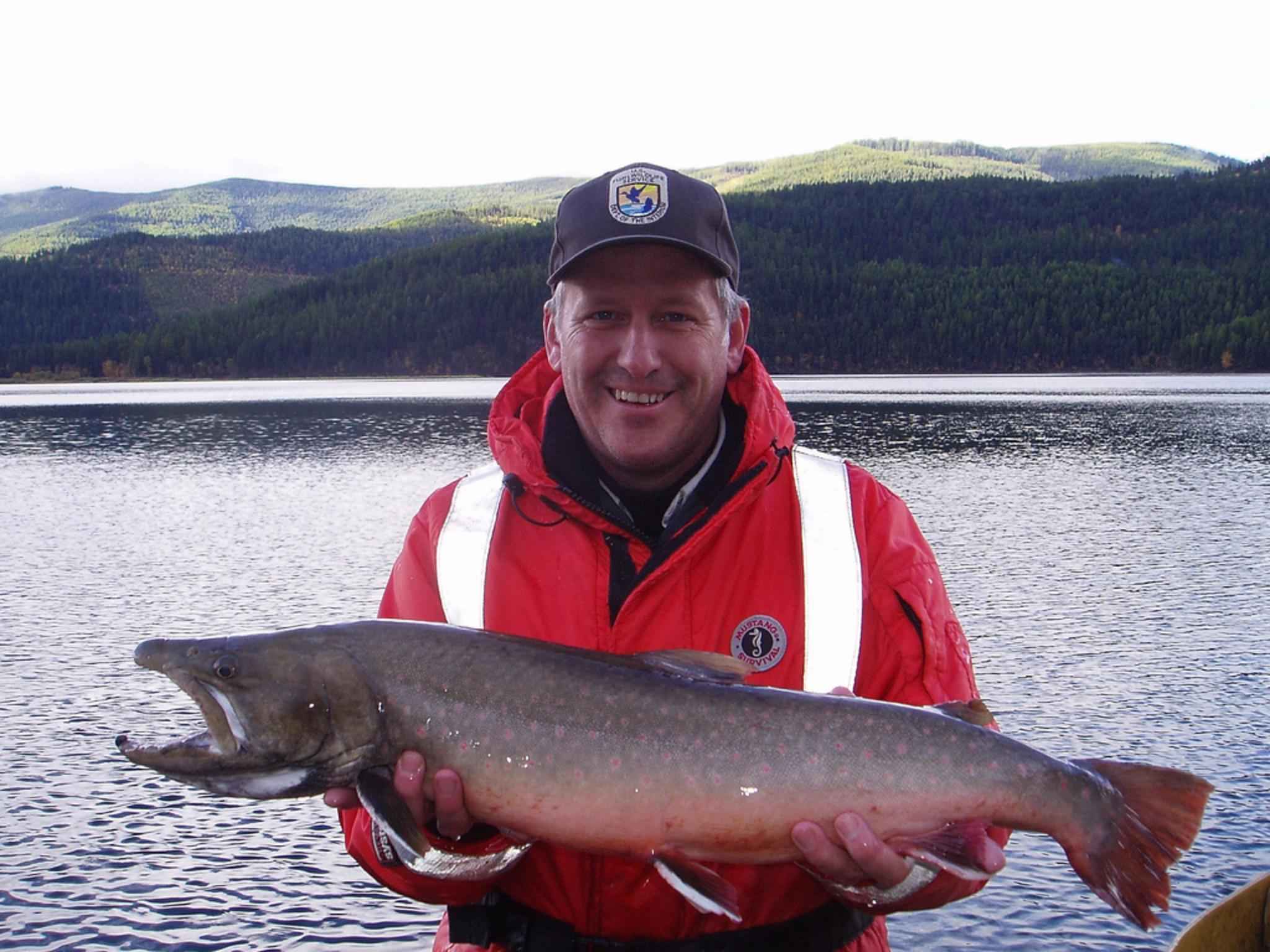|
Lake Koocanusa
Lake Koocanusa () is a reservoir in British Columbia (Canada) and Montana (United States) formed by the damming of the Kootenai River by the Libby Dam in 1972. The Dam was formally dedicated by President Gerald Ford on August 24, 1975. The lake is formed north of the dam, reaching to the Canada–United States border and further into British Columbia. The lake holds 13% of the water in the Columbia River system. The town of Rexford was moved, as well as the Great Northern Railway line. The town of Waldo, British Columbia is now covered by the lake. What was once a barrier to river travel, Jennings Canyon is now inundated by the lake. The Elk River joins the Kootenay River in the northern part of Lake Koocanusa, within Canadian territory. Lake Koocanusa was named in a contest won by Alice Beers of Rexford, Montana. The name is made from the first three letters of the Kootenay (alternately, Kootenai) River, Canada, and USA. Some confusion around the pronunciation of the lake ... [...More Info...] [...Related Items...] OR: [Wikipedia] [Google] [Baidu] |
Montana
Montana () is a state in the Mountain West division of the Western United States. It is bordered by Idaho to the west, North Dakota and South Dakota to the east, Wyoming to the south, and the Canadian provinces of Alberta, British Columbia, and Saskatchewan to the north. It is the fourth-largest state by area, the eighth-least populous state, and the third-least densely populated state. Its state capital is Helena. The western half of Montana contains numerous mountain ranges, while the eastern half is characterized by western prairie terrain and badlands, with smaller mountain ranges found throughout the state. Montana has no official nickname but several unofficial ones, most notably "Big Sky Country", "The Treasure State", "Land of the Shining Mountains", and " The Last Best Place". The economy is primarily based on agriculture, including ranching and cereal grain farming. Other significant economic resources include oil, gas, coal, mining, and lumber. The health ca ... [...More Info...] [...Related Items...] OR: [Wikipedia] [Google] [Baidu] |
The Narwhal (magazine)
''The Narwhal'' is a Canadian investigative online magazine that focuses on environmental issues. Organization It was launched by Carol Linnitt and Emma Gilchrist in May in 2018 and is a not-for-profit organization funded by membership subscriptions. Gilchrist is the editor-in-chief; the Ontario Bureau Chief is Denise Balkissoon; Amber Bracken is a regular contracted photojournalist. Activities Amber Bracken, on assignment for ''The Narwhal'', was arrested alongside CBC commissioned journalist Michael Toledano while reporting on the 2020 Canadian pipeline and railway protests The 2020 Canadian pipeline and railway protests were a series of civil disobedience protests held in Canada. The main issue behind the protests was the construction of the Coastal GasLink Pipeline (CGL) through of Wetʼsuwetʼen First Nations i .... The Narwhal was noted for their support of Bracken, in the context of her being an independent contractor. In 2021, ''The Narwhal'' journalist S ... [...More Info...] [...Related Items...] OR: [Wikipedia] [Google] [Baidu] |
Mountain Whitefish
The mountain whitefish (''Prosopium williamsoni'') is one of the most widely distributed salmonid fish of western North America. It is found from the Mackenzie River drainage in Northwest Territories, Canada south through western Canada and the northwestern USA in the Pacific, Hudson Bay and upper Missouri River basins to the Truckee River drainage in Nevada and Sevier River drainage in Utah. Description The body shape is superficially similar to the cyprinids, although it is distinguished by having the adipose fin of salmonids. The body is slender and nearly cylindrical in cross section, generally silver with a dusky olive-green shade dorsally. The scales possess pigmented borders, which are especially defined on the posterior end. Mountain Whitefish possess a forked homocercal tail. The short head has a small mouth underneath the snout. The short dorsal fin has 12–13 rays, with 11–13 for the anal fin, 10–12 for the pelvic fins, and 14–18 for the pectoral fins. Siz ... [...More Info...] [...Related Items...] OR: [Wikipedia] [Google] [Baidu] |
Longnose Sucker
The longnose sucker (''Catostomus catostomus'') is a species of cypriniform freshwater fish in the family Catostomidae. It is native to North America from the northern United States to the top of the continent. It is also found in Russia in rivers of eastern Siberia, and thus one of only two species of sucker native to Asia (the other is the Chinese ''Myxocyprinus asiaticus''). Description The body of the longnose sucker is long and round with dark olive or grey sides and top and a light underside. They are up to in total length and weigh up to . Longnose suckers are easily confused with white suckers (''Catostomus commersoni''), which appear very similar. However, longnose suckers can be distinguished by their comparatively finer scales. Distribution and ecology The longnose sucker inhabits cold, clear waters, including lakes, pools, rivers and streams, and occasionally also brackish waters. In North America, it ranges north from the Columbia, Delaware, Missouri and Mon ... [...More Info...] [...Related Items...] OR: [Wikipedia] [Google] [Baidu] |
Longnose Dace
The longnose dace (''Rhinichthys cataractae'') is a freshwater minnow native to North America. ''Rhinicthys'' means snout fish (reference to the long snout) and ''cataractae'' means of the cataract (first taken from Niagara Falls). Longnose dace are small, typically less than 100 mm and characterized by their fleshy snout that protrudes past the mouth. They are well adapted for living on the bottom of fast-flowing streams among stones. Longnose dace eat algae and aquatic insects and are important forage minnows for larger predatory fish. Description Longnose dace can be mistaken for suckers because of their subterminal "sucker-like" mouth. However, longnose dace (like all members of the family cyprinidae) lack small fleshy projections, called papillae, on their mouths. Juveniles have a black lateral line that extends from the beginning of the eye to the caudal fin that fades as the fish matures. The lateral line in juveniles is not present in all populations. In adults, ... [...More Info...] [...Related Items...] OR: [Wikipedia] [Google] [Baidu] |
Largescale Sucker
The largescale sucker (''Catostomus macrocheilus'') is a species of sucker, a type of freshwater fish, found in western North America. Description It has a rounded snout with a downturned mouth on its underside (as opposed to a mouth at end of the head like most fish). It has large scales and narrow tail base (caudal peduncle). Juveniles are under in length. Adults can reach a length of and in parts of their range. Juveniles are mottled brown or olive green with dark spots and white to yellow belly. Adults are bronze to orange on top with lighter undersides. Distribution and habitat The largescale sucker is native to the Pacific Northwest, occurring from British Columbia south to Oregon. It is widespread in the Columbia River system. It occurs in the slower-moving portions of rivers and streams, and in lakes. Biology Largescale suckers spawn in the spring in shallow water over sandy areas of streams or the sandy or small gravel shoals of lakes. Females may produce up to 20,0 ... [...More Info...] [...Related Items...] OR: [Wikipedia] [Google] [Baidu] |
Largemouth Bass
The largemouth bass (''Micropterus salmoides'') is a carnivorous freshwater gamefish in the Centrarchidae ( sunfish) family, a species of black bass native to the eastern and central United States, southeastern Canada and northern Mexico, but widely introduced elsewhere. It is known by a variety of regional names, such as the widemouth bass, bigmouth bass, black bass, bucketmouth, largies, Potter's fish, Florida bass, Florida largemouth, green bass, bucketmouth bass, Green trout, gilsdorf bass, Oswego bass, LMB, and southern largemouth and northern largemouth. The largemouth bass is the state fish of Georgia and Mississippi, and the state freshwater fish of Florida and Alabama. Taxonomy The largemouth bass was first formally described as ''Labrus salmoides'' in 1802 by the French naturalist Bernard Germain de Lacépède with the type locality given as the Carolinas. Lacépède based his description on an illustration of a specimen collected by Louis Bosc near Charleston, S ... [...More Info...] [...Related Items...] OR: [Wikipedia] [Google] [Baidu] |
Kokanee Salmon
The kokanee salmon (''Oncorhynchus nerka''), also known as the kokanee trout, little redfish, silver trout, kikanning, Kennerly's salmon, Kennerly's trout, or Walla, is the non-anadromous form of the sockeye salmon (meaning that they do not migrate to the sea, instead living out their entire lives in freshwater). There is some debate as to whether the kokanee and its sea-going relative are separate species; geographic isolation, failure to interbreed, and genetic distinction point toward a recent divergence in the history of the two groups. The divergence most likely occurred around 15,000 years ago when a large ice melt created a series of freshwater lakes and rivers across the northern part of North America. While some members of the salmon and trout family (salmonids) went out to sea (anadromous), others stayed behind in fresh water (non-anadromous). The separation of the sockeye and the kokanee created a unique example of sympatric speciation that is relatively new in evolutiona ... [...More Info...] [...Related Items...] OR: [Wikipedia] [Google] [Baidu] |
Burbot
The burbot (''Lota lota'') is the only gadiform (cod-like) freshwater fish Freshwater fish are those that spend some or all of their lives in fresh water, such as rivers and lakes, with a salinity of less than 1.05%. These environments differ from marine conditions in many ways, especially the difference in levels of .... It is also known as bubbot, mariah, loche, cusk, freshwater cod, freshwater ling, freshwater cusk, the lawyer, coney-fish, lingcod, and eelpout. The species is closely related to the marine common ling and the cusk (fish), cusk. It is the monotypic, only member of the genus ''Lota''. For some time of the year, the burbot lives under ice, and it requires frigid temperatures to breed. Etymology The name burbot comes from the Latin word ''barba'', meaning beard, referring to its single chin whisker, or barbel (anatomy), barbel. Its generic and specific names, ''Lota lota'', comes from the old French ''lotte'' fish, which is also named "barbot" in Old French. ... [...More Info...] [...Related Items...] OR: [Wikipedia] [Google] [Baidu] |
Bull Trout
The bull trout (''Salvelinus confluentus'') is a char of the family Salmonidae native to northwestern North America. Historically, ''S. confluentus'' has been known as the " Dolly Varden" (''S. malma''), but was reclassified as a separate species in 1980. Bull trout are listed as a threatened species under the U.S. Endangered Species Act (1998) and as vulnerable on the IUCN Red List of Threatened Species. Description Like other species of char, the fins of a bull trout have white leading edges. Its head and mouth are unusually large for salmonids, giving it its name. Bull trout have been recorded measuring up to in length and weighing . Bull trout may be either migratory, moving throughout large river systems, lakes, and the ocean, or they may be resident, remaining in the same stream their entire lives. Migratory bull trout are typically much larger than resident bull trout, which rarely exceed . Bull trout can be differentiated from brook trout (''S. fontinalis'') by the absen ... [...More Info...] [...Related Items...] OR: [Wikipedia] [Google] [Baidu] |
Brook Trout
The brook trout (''Salvelinus fontinalis'') is a species of freshwater fish in the char genus ''Salvelinus'' of the salmon family Salmonidae. It is native to Eastern North America in the United States and Canada, but has been introduced elsewhere in North America, as well as to Iceland, Europe, and Asia. In parts of its range, it is also known as the eastern brook trout, speckled trout, brook charr, squaretail, brookie or mud trout, among others. A potamodromous population in Lake Superior, as well as an anadromous population in Maine, is known as coaster trout or, simply, as coasters. The brook trout is the state fish of nine U.S. states: Michigan, New Hampshire, New Jersey, New York, North Carolina, Pennsylvania, Vermont, Virginia, and West Virginia, and the Provincial Fish of Nova Scotia in Canada. Systematics and taxonomy The brook trout was first scientifically described as ''Salmo fontinalis'' by the naturalist Samuel Latham Mitchill in 1814. The specific epithet "''fontina ... [...More Info...] [...Related Items...] OR: [Wikipedia] [Google] [Baidu] |
Cutthroat Trout
The cutthroat trout is a fish species of the family Salmonidae native to cold-water tributaries of the Pacific Ocean, Rocky Mountains, and Great Basin in North America. As a member of the genus '' Oncorhynchus'', it is one of the Pacific trout, a group that includes the widely distributed rainbow trout. Cutthroat trout are popular gamefish, especially among anglers who enjoy fly fishing. The common name "cutthroat" refers to the distinctive red coloration on the underside of the lower jaw. The specific name ''clarkii'' was given to honor explorer William Clark, coleader of the Lewis and Clark Expedition. Cutthroat trout usually inhabit and spawn in small to moderately large, clear, well- oxygenated, shallow rivers with gravel bottoms. They reproduce in clear, cold, moderately deep lakes. They are native to the alluvial or freestone streams that are typical tributaries of the rivers of the Pacific Basin, Great Basin and Rocky Mountains. Cutthroat trout spawn in the spring ... [...More Info...] [...Related Items...] OR: [Wikipedia] [Google] [Baidu] |









